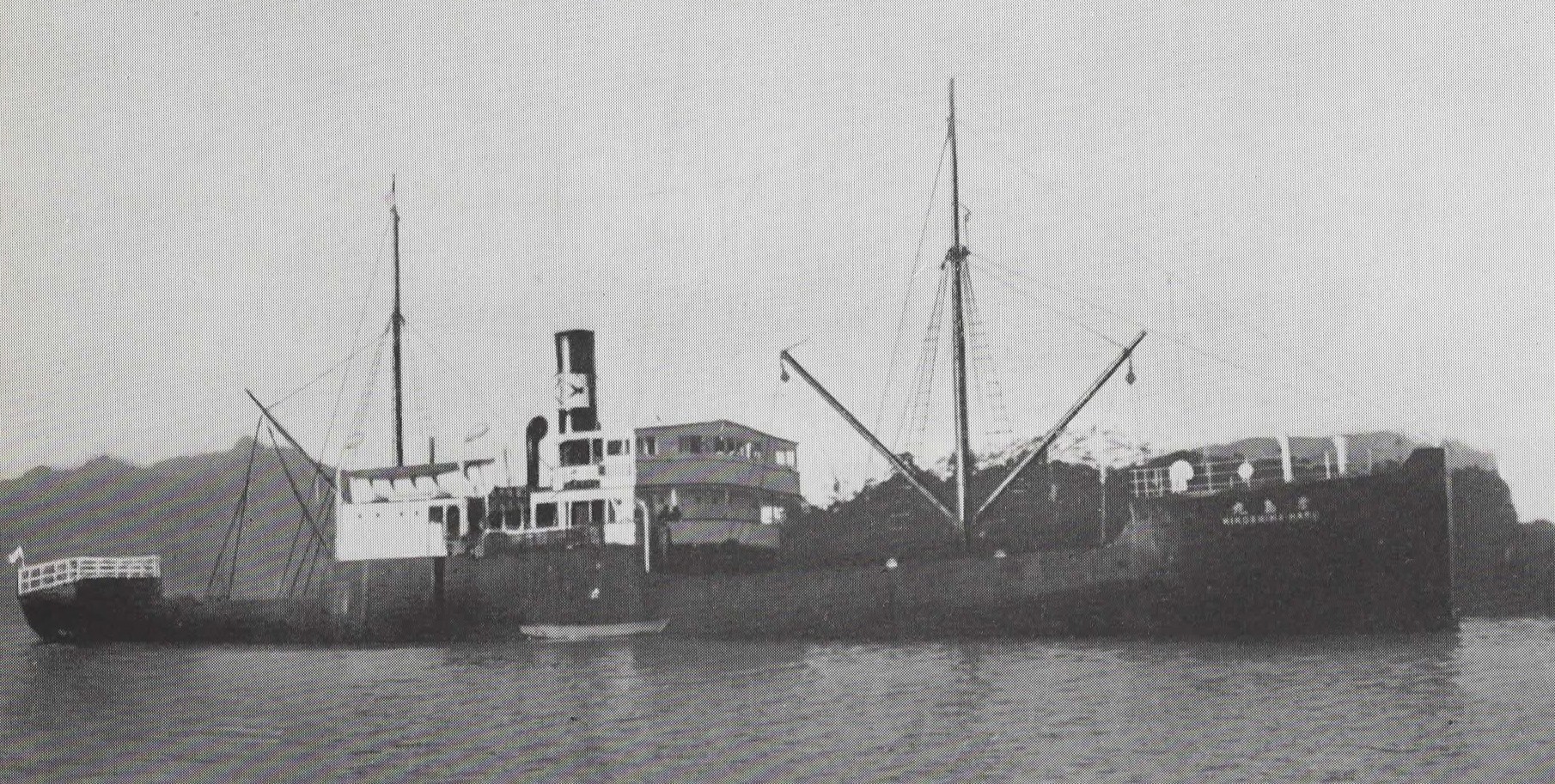ZATSUYOSEN!
 (HIKOSHIMA MARU prewar – Erich Muehlthaler’s collection)
(HIKOSHIMA MARU prewar – Erich Muehlthaler’s collection)
IJN HIKOSHIMA MARU:
Tabular Record of Movement
© 2015 Gilbert Casse and Peter Cundall
E 1917:
Mitsunosho. Laid down by Bingo Dock K.K. shipyard for Moji Shosen K.K. as a 951-tons cargo ship.
June 1918:
Launched and named HIKOSHIMA MARU. [1]
1918:
Completed and registered at Moji. Her Gross Registered Tonnage (GRT) and Net Registered Tonnage (NRT) respectively are 951-tons and 648-tons. [2]
1928:
Her owners are changed to Iino Torakichi and port of registry to Fuchu, Kyoto Prefecture.
24 May 1933:
Her port of registry is changed to Tokyo.
1936:
Her GRT and NRT are respectively changed to 963-tons and 655-tons. [2]
1939:
Her GRT and NRT are respectively changed to 977-tons and 669-tons. [2]
1940:
Her GRT and NRT are respectively changed to 966-tons and 658-tons. [2]
12 May 1943:
Specified as primary Naval ship.
16 October 1943:
Requisitioned by the IJN as a general requisitioned transport attached to the Kure Naval District.
17 October 1943:
Departs Moji.
19 October 1943:
Arrives at Osaka.
21 October 1943:
Departs Osaka.
22 October 1943:
Arrives at Kure.
23 October 1943:
Departs Kure.
24 October 1943:
Arrives at Yawata, Fukuoka Prefecture.
26 October 1943:
Departs Yawata and arrives at Moji later that day.
27 October 1943:
Departs Moji.
28 October 1943:
Arrives at Mihonoseki, Shimane Prefecture. Departs there and arrives at Maizuru later that same day. Unloads 904-tons of steel and other sundries.
31 October 1943:
Departs Maizuru and arrives at Miyazu, Kyoto Prefecture later in the day.
1 November 1943:
Departs Miyazu.
2 November 1943:
Arrives off Hikoshima, Shimonoseki Prefecture.
3 November 1943:
Departs Hikoshima waters and arrives at Tokuyama, Yamaguchi Prefecture later that day.
9 November 1943:
Departs Tokuyama and arrives S of Hayase Seto, Hiroshima Prefecture later that same day.
10 November 1943:
Departs Hayase Seto waters and arrives at Kure. Starts conversion to military duty at the Naval Yard later in the day.
17 November 1943:
The conversion is completed. Departs Kure.
18 November 1943:
Arrives at Tokuyama.
20 November 1943:
Departs Tokuyama and arrives at Hezaki, Kyushu later that day.
21 November 1943:
Departs Hezaki and arrives at Wakamatsu, Fukuoka Prefecture later that same day.
22 November 1943:
Departs Wakamatsu.
26 November 1943:
Arrives at Ominato, Aomori Prefecture.
9 December 1943:
Departs Ominato towing a small boat.
December 1943:
Calls at Funakawa, Akita Prefecture ~ Tsuruga, Fukui Prefecture ~ Chongjin, Chosen (now North Korea) and Wakamatsu.
1 January 1944:
Arrives at Kobe. Registered that same day in the Navy’s list as an auxiliary transport (Otsu) category attached to the Kure Naval District with Kure as home port under instruction No. 16. Assigned to Vice Admiral (Admiral posthumously) Endo Yoshizaku’s (39) Ninth Fleet. [3]
January 1944:
Assigned to New Guinea troops reinforcements Movement No. 6.
4 January 1944:
Departs Kobe.
7 January 1944:
Arrives at Tokyo.
11 January 1944:
Departs Tokyo.
13 January 1944:
Arrives at Nagoya.
19 February 1944:
Departs Nagoya and arrives at Yokkaichi, Mie Prefecture later in the day.
22 February 1944:
Departs Yokkaichi.
23 February 1944:
Arrives at Yokohama.
28 February 1944:
Departs Yokohama.
8 March 1944:
Arrives at Futami, Chichi-Jima, Ogasawara Gunto (Bonins).
15 March 1944:
At 0800 (ETD), departs Futami escorted by auxiliary minesweeper TOSHI MARU No. 5.
20 March 1944:
Arrives at Saipan, Marianas.
7 April 1944:
Departs Saipan.
E April 1944:
Arrives at Palau, Western Carolines.
3 May 1944:
Departs Davao, Mindanao.
4 May 1944:
Reverses course.
6 May 1944:
Arrives back at Davao.
17 May 1944:
At 0010, departs Davao again escorted by minesweeper W-22.
23 May 1944:
At 1050, arrives at Palau.
24 May 1944:
At 1054, departs Palau escorted by minesweeper W-22 and auxiliary subchasers CHa-61 and CHa-64.
26 May 1944:
At 1640, arrives at Yap, Carolines.
29 May 1944:
At 0530, departs Yap escorted by minesweeper W-22 and auxiliary subchasers CHa-61 and CHa-64.
31 May 1944:
At 1030, arrives at Palau.
8 June 1944:
At 0635, departs Palau escorted by auxiliary minesweeper SHONAN MARU No. 3 and auxiliary subchaser CHa-61.
10 June 1944:
At 1130, arrives at Yap.
E 11-12 June 1944:
Undergoes unloading operations.
13 June 1944:
At 0630, departs Yap escorted by auxiliary minesweeper SHONAN MARU No. 3 and auxiliary subchaser CHa-61.
15 June 1944:
Arrives in Saipan waters and departs there towards Davao.
17 June 1944:
Arrives in Davao waters and departs there towards Palau.
18 June 1944:
Kayangel Atoll, about 43 nautical miles NNE of Koror, Palaus. Strikes a reef and is stranded. SHONAN MARU No. 3 also strands but is able to refloat herself.
20 June 1944:
SHONAN MARU No. 3 while acting as guardship for stranded HIKOSHIMA MARU is bombed and sunk with unknown casualties.
25 July 1944:
Bombed by American TF.58 carrier based aircraft. The transport is wrecked at 06-30N, 134-30E with the loss of 20 of her crew.
3 May 1947:
Removed from the Navy’s list under instruction No. 327.
Authors notes :
[1] Not to be confused with IJA shared tanker (A/C-AO) No. 5250 (2,854 GRT, ’44).
[2] NRT is a ship's cargo volume capacity expressed in "register tons", one of which equals to a volume of 100 cubic feet (2.83 m3). It is calculated by subtracting non-revenue-earning spaces i.e. spaces not available for carrying cargo, for example engine rooms, fuel tanks and crew quarters, from the ship's gross register tonnage (GRT). Net register tonnage (NRT) is not a measure of the weight of the ship or its cargo, and should not be confused with terms such as deadweight tonnage or displacement.
[3] There were two categories of Zatsuyosen. (Ko) category with an IJN Captain as supervisor aboard and (Otsu) category without.
Thanks go to Gengoro S. Toda of Japan.
Gilbert Casse and Peter Cundall.
Back to
IJN Transports Page





